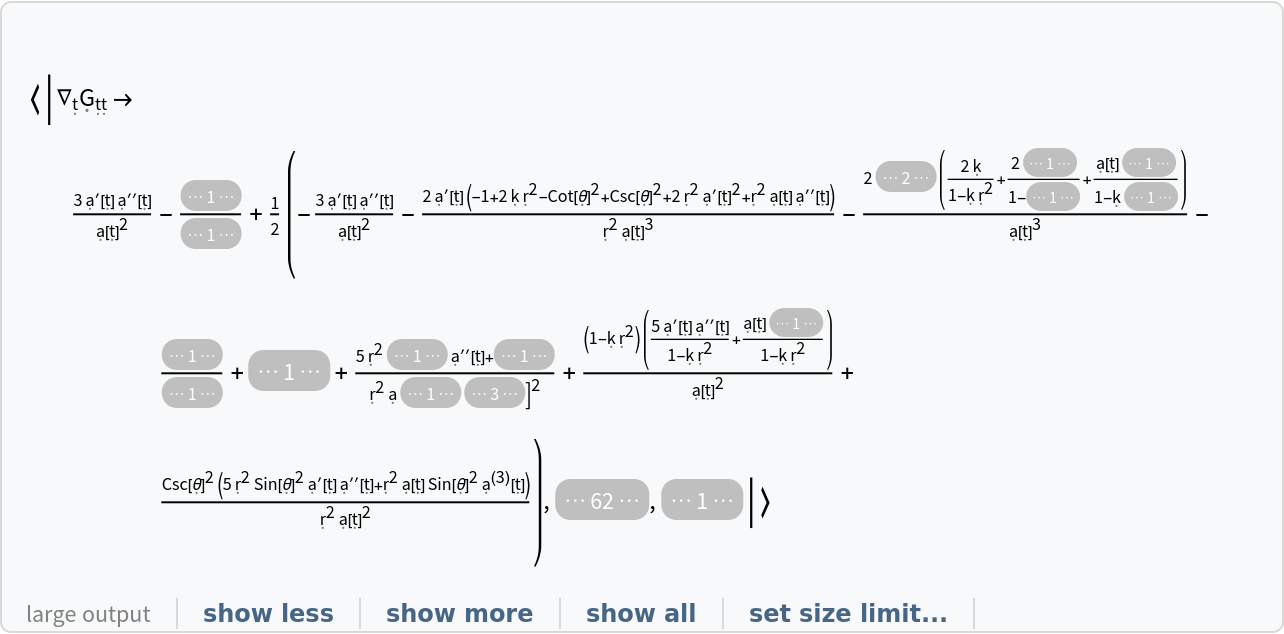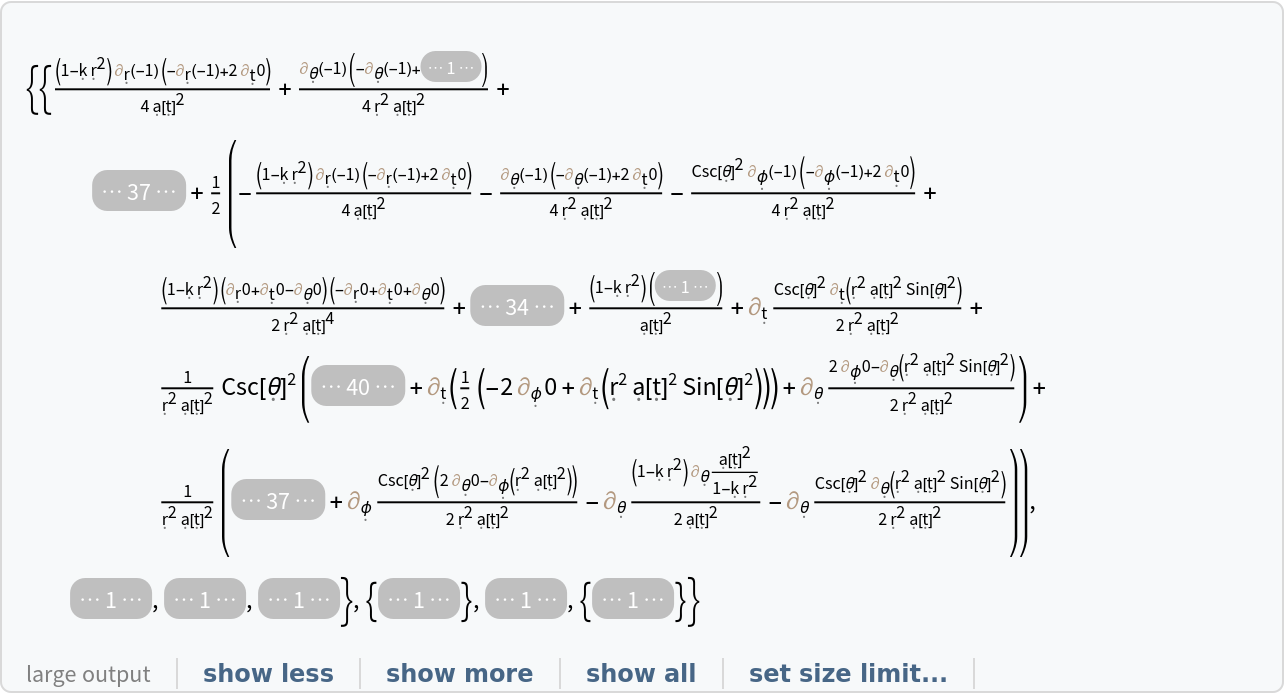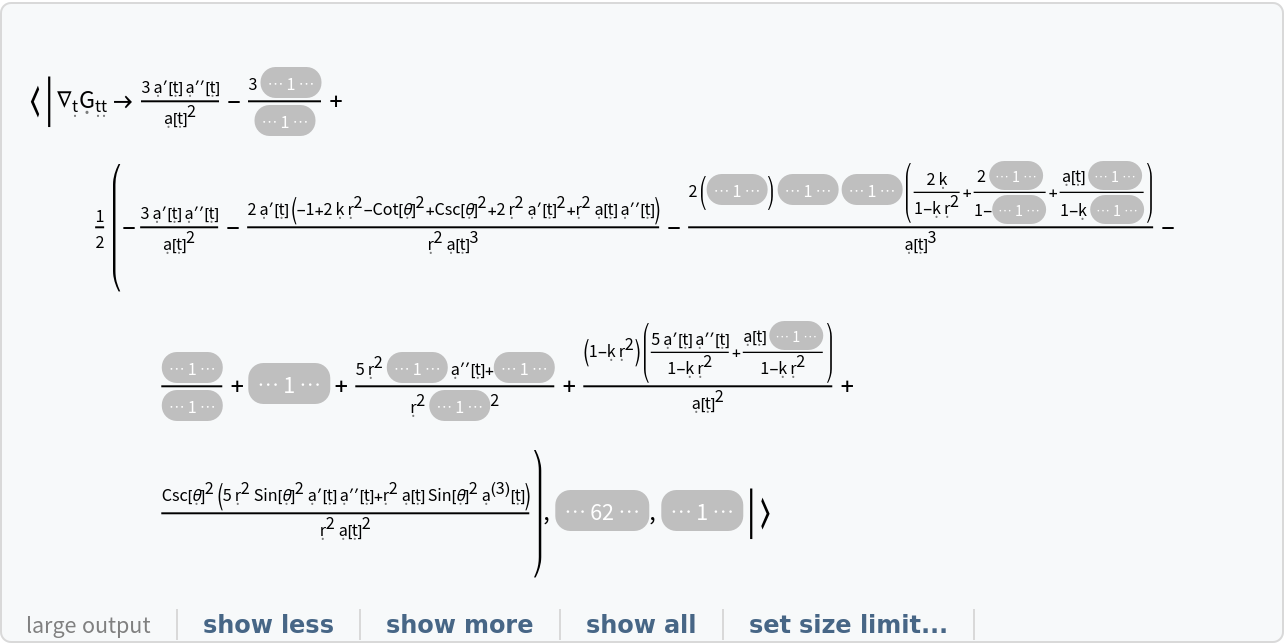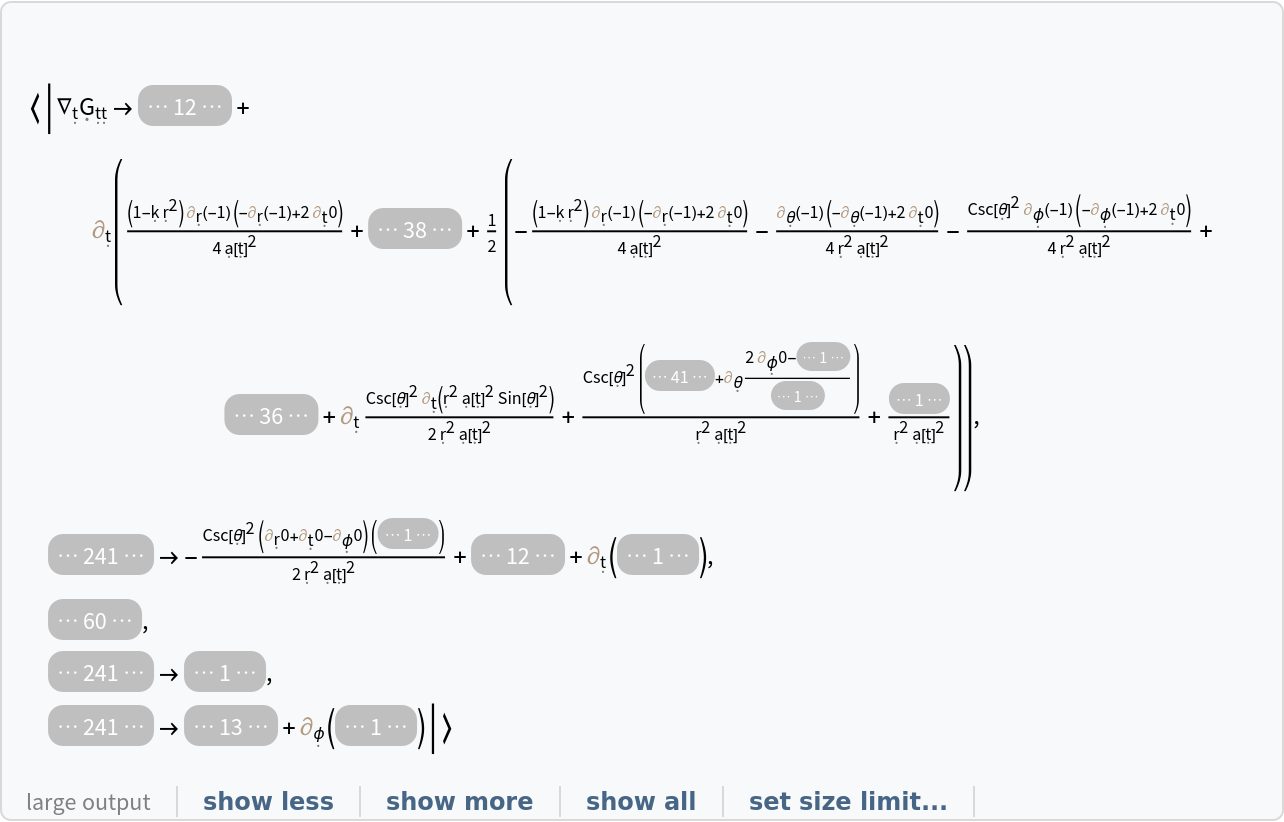Basic Examples (3)
Construct the Einstein curvature tensor for the Schwarzschild metric (e.g. for an uncharged, non-rotating black hole with symbolic mass "M") in standard spherical polar coordinates:
Show the Einstein curvature tensor for the Schwarzschild metric in explicit (covariant) matrix form:
Show the Einstein curvature tensor for the Schwarzschild metric in explicit (covariant) matrix form, with all algebraic equivalences imposed:
Deduce that the Schwarzschild metric is Einstein-flat:
Show the list of Schwarzschild coordinate symbols:
Show the list of differential 1-form symbols for each of the Schwarzschild coordinates:
Show the list of coordinate conditions that must hold for the Schwarzschild metric to be Lorentzian:
Construct the Einstein curvature tensor for the Friedmann-Lemaître-Robertson-Walker (FLRW) metric (for a homogeneous, isotropic and uniformly-expanding/contracting universe, with symbolic curvature parameter "k" and symbolic scale factor "a") in standard spherical polar coordinates:
Show the explicit matrix form, with all algebraic equivalences imposed:
Deduce that the FLRW metric is not Einstein-flat:
Show the list of conditions that must hold for the FLRW metric to be Einstein-flat:
Show the trace of the Einstein curvature tensor for the FLRW metric:
Show the trace of the Einstein curvature tensor for the FLRW metric, with all algebraic equivalences imposed:
Deduce that the trace of the Einstein curvature tensor for the FLRW metric is non-vanishing:
Show the condition that must hold for the FLRW metric to have a vanishing trace of the Einstein curvature tensor:
Show the list of coordinate values that cause the Einstein curvature tensor for the FLRW metric to become singular:
Show the list of coordinate values that cause the trace of the Einstein curvature tensor for the FLRW metric to become singular:
Show the association of all covariant derivatives (i.e. derivatives along tangent vectors of the manifold) of the Einstein curvature tensor for the FLRW metric:
Show the association of all covariant derivatives of the Einstein curvature tensor for the FLRW metric, with all algebraic equivalences imposed:
Show the list of all (contracted) Bianchi identities asserting that the covariant divergence of the Einstein curvature tensor vanishes for the FLRW metric:
Show that the (contracted) Bianchi identities for the FLRW metric all hold identically:
Construct the Einstein curvature tensor for the Kerr-Newman metric (e.g. for a charged, spinning black hole with symbolic mass "M", symbolic angular momentum "J" and symbolic electric charge "Q") in Boyer-Lindquist/oblate spheroidal coordinates:
Extract (and simplify) the time-time component of the Einstein curvature tensor for the Kerr-Newman metric:
Extract (and simplify) the first row of the Einstein curvature tensor for the Kerr-Newman metric in matrix form:
Extract (and simplify) the first column of the Einstein curvature tensor for the Kerr-Newman metric in matrix form:
Compute the contravariant form of the Einstein curvature tensor (with both indices raised):
Compute a mixed form of the Einstein curvature tensor with one index raised/contravariant and one index lowered/covariant:
Transform to use the new coordinate symbols t, r, a1 and a2:
Transform to use the new coordinate symbols t, r, a1 and a2, and raise both indices, simultaneously:
Scope (3)
Einstein curvature tensors can be constructed directly from a MetricTensor expression:
Additional arguments can be used to specify the coordinate symbols (otherwise default symbols will be chosen automatically):
Or the indices (True for lowered/covariant and False for raised/contravariant - otherwise both indices will be set as lowered/covariant by default):
Or both simultaneously:
New coordinate symbols can be specified for any Einstein curvature tensor:
Indices can also be raised and lowered on any Einstein curvature tensor:
New coordinate symbols and new index positions can also be specified simultaneously:
Construct the Einstein curvature tensor for the FLRW metric, with symbolic curvature parameter "k" and symbolic scale factor "a":
Show the list of properties:
Show the explicit matrix representation of the Einstein curvature tensor:
Show the explicit matrix representation of the Einstein curvature tensor, with all algebraic equivalences imposed:
Show the explicit matrix representation of the Einstein curvature tensor, with all partial derivative operators left purely symbolic:
Show the trace of the Einstein curvature tensor:
Show the trace of the Einstein curvature tensor, with all algebraic equivalences imposed:
Show the trace of the Einstein curvature tensor, with all partial derivative operators left purely symbolic:
Show the metric tensor for the underlying manifold represented by the Einstein curvature tensor:
Show the list of coordinate symbols for the Einstein curvature tensor:
Show the list of differential 1-form symbols for the coordinates of the Einstein curvature tensor:
Show the list of booleans specifying the positions of the indices of the Einstein curvature tensor (True for lowered/covariant and False for raised/contravariant):
Determine whether the Einstein curvature tensor is covariant (i.e. both indices are lowered/covariant):
Determine whether the Einstein curvature tensor is contravariant (i.e. both indices are raised/contravariant):
Determine whether the Einstein curvature tensor is mixed (i.e. one index is lowered/covariant and one index is raised/contravariant):
Show a symbolic representation of the Einstein curvature tensor with appropriately raised/lowered indices:
Determine whether the underlying manifold is Einstein-flat (i.e. all components of the Einstein curvature tensor vanish):
Determine whether the underlying manifold has a vanishing trace of the Einstein curvature tensor:
Show the list of conditions required to guarantee that the underlying manifold is Einstein-flat (i.e. all components of the Einstein curvature tensor vanish):
Show the condition required to guarantee that the underlying manifold has a vanishing trace of the Einstein curvature tensor:
Show the association of all covariant derivatives (i.e. all derivatives along tangent vectors of the underlying manifold) of the Einstein curvature tensor:
Show the association of all covariant derivatives (i.e. all derivatives along tangent vectors of the underlying manifold) of the Einstein curvature tensor, with all algebraic equivalences imposed:
Show the association of all covariant derivatives (i.e. derivatives along tangent vectors of the underlying manifold) of the Einstein curvature tensor, with all partial derivative operators left purely symbolic:
Show the list of all (contracted) Bianchi identities asserting that the covariant divergence of the Einstein curvature tensor must vanish:
Show the list of all (contracted) Bianchi identities asserting that the covariant divergence of the Einstein curvature tensor must vanish, with all partial derivative operators left purely symbolic:
Show the number of dimensions of the underlying manifold represented by the Einstein curvature tensor:
Determine whether the Einstein curvature tensor is symmetric (in explicit, covariant matrix form):
Determine whether the Einstein curvature tensor is diagonal (in explicit, covariant matrix form):
Show the signature of the underlying manifold represented by the Einstein curvature tensor (with +1s representing positive eigenvalues and -1s representing negative eigenvalues of the metric tensor):
Determine whether the underlying manifold represented by the Einstein curvature tensor is Riemannian (i.e. all eigenvalues of the metric tensor have the same sign):
Determine whether the underlying manifold represented by the Einstein curvature tensor is pseudo-Riemannian (i.e. all eigenvalues are non-zero, but not all have the same sign):
Determine whether the underlying manifold represented by the Einstein curvature tensor is Lorentzian (i.e. all eigenvalues of the metric tensor have the same sign, except for one eigenvalue which has the opposite sign):
Show the list of conditions on the coordinates required to guarantee that the underlying manifold represented by the Einstein curvature tensor is Riemannian (i.e. all eigenvalues of the metric tensor are positive):
Show the list of conditions on the coordinates required to guarantee that the underlying manifold represented by the Einstein curvature tensor is pseudo-Riemannian (i.e. all eigenvalues of the metric tensor are non-zero):
Show the list of conditions on the coordinates required to guarantee that the underlying manifold represented by the Einstein curvature tensor is Lorentzian (i.e. the "time" eigenvalue is negative, and all other eigenvalues are positive):
Show the list of coordinate values that cause the Einstein curvature tensor to become singular:
Show the list of coordinate values that cause the trace of the Einstein curvature tensor to become singular:
Show the determinant of the Einstein curvature tensor (when represented as a covariant matrix):
Show the determinant of the Einstein curvature tensor (when represented as a covariant matrix), with all algebraic equivalences imposed:
Show the determinant of the Einstein curvature tensor (when represented as a covariant matrix), with all partial derivative operators left purely symbolic:
Show the eigenvalues of the Einstein curvature tensor (when represented as a covariant matrix):
Show the eigenvalues of the Einstein curvature tensor (when represented as a covariant matrix), with all algebraic equivalences imposed:
Show the eigenvectors of the Einstein curvature tensor (when represented as a covariant matrix):
Show the eigenvectors of the Einstein curvature tensor (when represented as a covariant matrix), with all algebraic equivalences imposed:
Compute the covariant form of the Einstein curvature tensor (with both indices lowered/covariant):
Compute the contravariant form of the Einstein curvature tensor (with both indices raised/contravariant):



















































